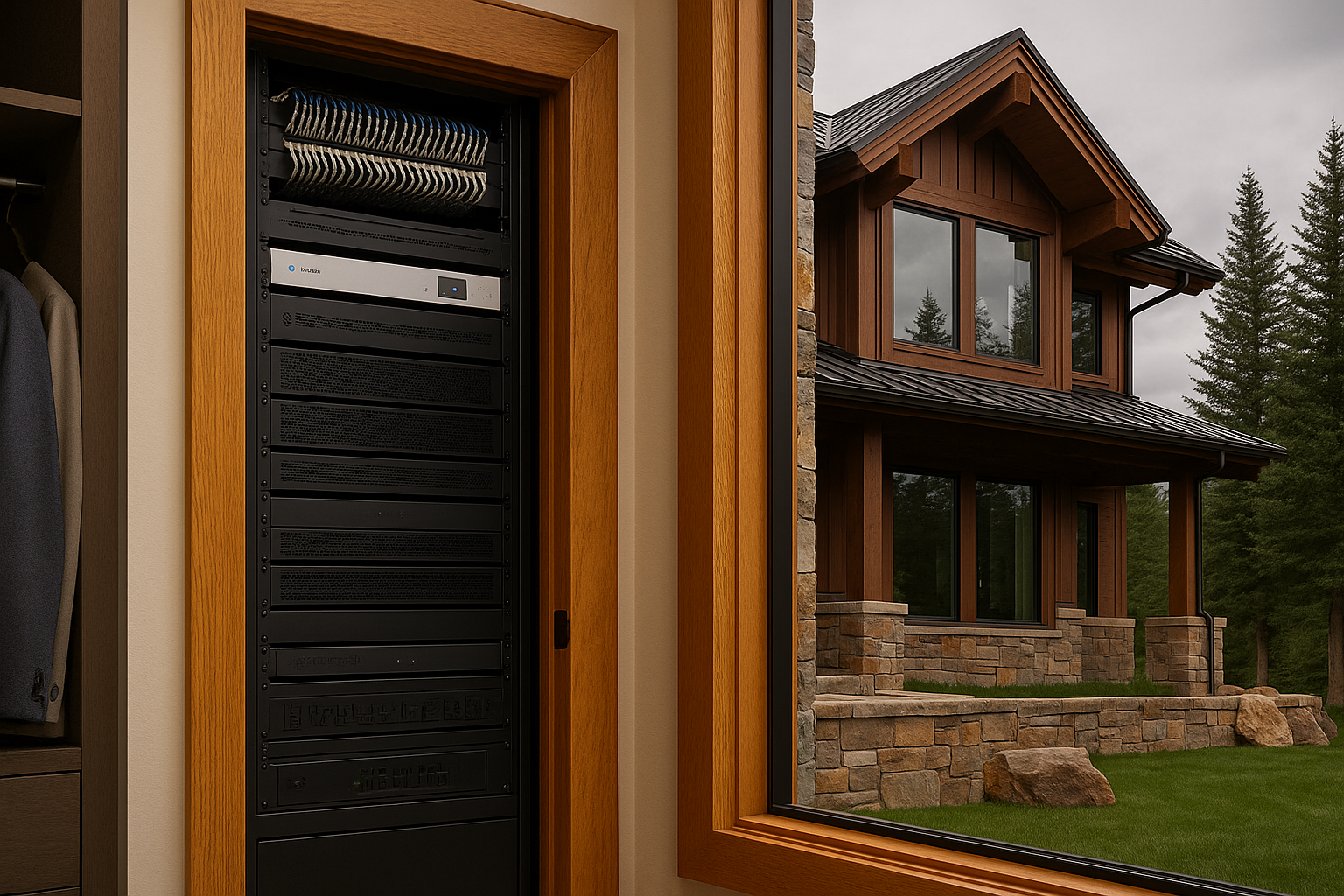Here’s something we hate telling homeowners: their beautiful million-dollar mountain home has the Wi-Fi performance of a budget motel.
Unfortunately, it happens more than you’d expect. Poor network performance is consistently our number one post-installation service call, usually accompanied by the question, “Why won’t my smart TV connect upstairs?”
After 30+ years of integrating technology in Colorado’s luxury homes, we’ve learned that network infrastructure isn’t something you can add as an afterthought. Today, we’re sharing insights from our field team about why network integration needs to happen during construction – not after move-in.
The Reality Check: What Our Installers See
“This Beautiful Home is a Wi-Fi Dead Zone”
Last winter, we were called to a stunning ski-in/ski-out property featuring soaring steel beam ceilings and walls of reclaimed timber. Architecturally breathtaking – and an absolute nightmare for wireless signal propagation.
The materials that make Colorado luxury homes spectacular – massive stone fireplaces, metal roof structures, reinforced concrete – these same elements block wireless signals like a fortress. Even premium mesh systems that work well in standard homes simply can’t penetrate these challenging environments.
By the time we arrived, the options were limited: tear into finished walls to install proper access points, or mount visible equipment that compromised the home’s aesthetic. Neither option thrilled anyone involved.
The better approach? Pre-construction network planning that accounts for these materials from day one.
“Beautiful Design, Nowhere to Put the Equipment”
We’ve arrived at gorgeous homes only to discover the designated “tech closet” was tucked behind the wine cellar, next to the steam shower, with no ventilation or proper power.
Modern luxury homes demand enterprise-grade networking equipment that requires proper ventilation, surge protection, and accessibility for maintenance. This isn’t just about hiding a router – it’s about creating the infrastructure that every smart device in the home depends on.
Working with builders and interior designers during early planning phases allows us to coordinate equipment placement with cabinetry, HVAC, and aesthetic requirements. One early conversation prevents dozens of headaches later.
“The Guest House Became an Internet Island”
We received an urgent call mid-ski season about slow streaming in a home’s guest wing. The builder had logically separated electrical and HVAC zones, but the network infrastructure stopped at the main house.
Large luxury homes need enterprise-grade networks capable of handling multiple zones, VLAN management, and seamless roaming between access points. Residential routers simply aren’t designed for 15,000 square foot homes with detached guest quarters and outdoor entertainment areas.
The Hidden Cost of Poor Network Planning
Here’s what many people don’t realize: when smart devices malfunction, the problem usually isn’t the device – it’s the network supporting it.
Homeowners call frustrated because their motorized shades won’t respond or their streaming system shows “offline.” They assume their expensive control systems are defective. In reality, 90% of these issues trace back to inadequate network infrastructure.
According to recent industry data, unreliable networking remains the top complaint in smart homes nationwide, despite homeowners investing thousands in connected devices and systems.
Colorado’s Unique Network Challenges
Colorado luxury homes present specific challenges that standard networking solutions can’t address:
Construction Materials: Log beams, natural stone, and steel structures dramatically reduce Wi-Fi range. Signal strength drops significantly after penetrating just one structural wall in most mountain homes.
Environmental Factors: Altitude effects, temperature extremes, and seasonal variations impact equipment performance and require specialized solutions.
Property Scale: Many luxury properties include detached guest houses, outdoor living spaces, ski storage areas, and wellness facilities – all requiring reliable connectivity.
Multi-Seasonal Use: Homes that transition between full-time and seasonal occupancy need networks that maintain performance whether the house is occupied or vacant.
What Trade Partners Can Do Differently
Based on our experience across hundreds of Colorado luxury home projects, here’s how architects, builders, and designers can ensure better outcomes:
Early Collaboration
Include network planning in initial design phases, not as a last-minute addition. We can provide invisible infrastructure plans that integrate seamlessly with architectural and interior design goals.
Proper Infrastructure Planning
Allocate appropriate space for network equipment with proper ventilation, power, and accessibility. Network racks have specific requirements that differ from general storage needs.
Realistic Client Expectations
Help homeowners understand that reliable smart home performance requires professional-grade infrastructure, not consumer electronics from big-box stores.
Integrated Design Approach
Coordinate network placement with lighting, audio, and control system requirements. These systems work together and benefit from unified planning.
The Xssentials Approach
After decades of solving network challenges in luxury homes, we’ve developed proven strategies that deliver reliable performance:
Enterprise-Grade Equipment: We use commercial-grade networking hardware designed for 24/7 operation and professional management, not consumer routers.
Remote Monitoring: Our systems include proactive monitoring that identifies and often resolves issues before homeowners notice them.
Proper Network Segmentation: Smart TVs, security cameras, lighting controls, and computers operate on separate network segments for optimal performance and security.
Scalable Design: Networks are designed to handle peak usage – holiday gatherings, multiple streaming sessions, and intensive smart home automation – without performance degradation.
The Bottom Line
You wouldn’t install a premium kitchen without planning the gas lines, or design dramatic lighting without proper electrical infrastructure. Network planning deserves the same attention.
Modern luxury homes depend on robust networking for everything from climate control and security to entertainment and communication. When that foundation is properly designed and professionally installed, technology enhances the living experience seamlessly.
When it’s treated as an afterthought, even the most beautiful homes suffer from frustrating performance issues that could have been easily prevented.
Ready to Plan Your Network Infrastructure?
Whether you’re designing a mountain retreat or an urban luxury residence, proper network planning makes the difference between technology that enhances your clients’ lives and technology that creates ongoing frustration.
Contact our team to discuss network integration for your next project. We’ll work with your design and construction team to create invisible infrastructure that delivers reliable performance for years to come.
